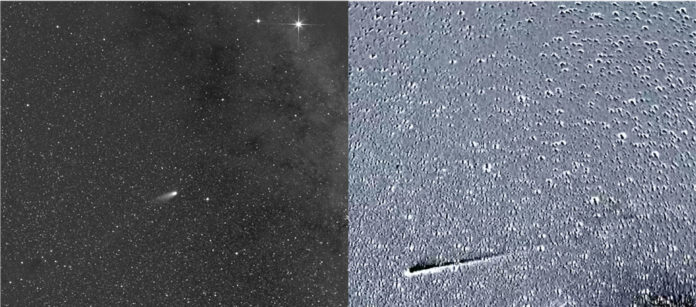On Dec.12, 2021, comet Leonard, also known as C/2021 A1, made its closest approach to Earth. Discovered almost a year ago, it was the brightest comet in 2021 that passed by Earth, lighting up the sky.
Recent updates suggest that this brightest comet has disintegrated into pieces during its perihelion on January 3, 2022, or closest to the Sun. Besides getting faded, the comet is missing two crucial parts: its nucleus (core) and its coma (temporary atmosphere).
G. J. Leonard discovered the comet C/2021 A1 (Leonard) at the Mount Lemmon Observatory on January 3, 2021. At the time of its discovery, it was 750 million km) from the Sun. It had a nucleus about 1 km (0.6 mi) across.
G. J. Leonard told EarthSky, “C/2021 A1’s legacy will likely be the spectacular outburst-induced displays of its ion tail structures. Otherworldly and astonishing are the only descriptions that come to mind when I began viewing the images posted online by a handful of dedicated expert astrophotographers, particularly after December 19, 2021, when the comet began undergoing strong periodic outburst activity.”
In late November 2021, astronomers wondered if the comet was beginning to disintegrate. They spotted several signs, including faded brightness, asymmetrical shape of the head of the comet- the comet’s head did not appear round, and its path seemed to be veering off course.
After several months, astronomers realized that the comet did not disintegrate in December. Either the moonlight was affecting the brightness of a change of volatile gases the comet was consuming might be responsible. And as a comet goes from boiling off carbon dioxide to boiling off the water, it will sometimes have a slight dip in brightness. That’s what happened in late November 2021, reported EarthSky.
Comet’s head indicates the unusual activity with a comet’s nucleus. Comet Leonard’s coma was somewhat triangular, with one of the bases of the triangle pointed toward the Sun. This is unusual yet did not indicate the breakup of the nucleus.
EarthSky reported, “On December 2, 2021, the Central Bureau for Astronomical Telegrams issued Electronic Telegram #5077 to dispel the fears that the comet was disintegrating. Daniel Green wrote that the comet was brightening more or less as predicted. It said the positions of the comet for November 29 were not accurate and should not be used to determine the comet’s direction. It then issued predictions for future positions and brightness.”
The comet which passes near the Sun should be brighter to survive. However, the comet Leonard did not get unusually close to the Sun. Based on its brightness profile, astronomers assumed that it would probably survive.
Later, on January 3, 2022, astronomers spotted fluctuations in its brightness every three to five days during its approach to perihelion. The comet’s tail began to show some complicated structure, possibly due to pieces breaking off the nucleus.
It was challenging to observe the comet by this time as it was located in the southern evening sky, not far from the Sun. Yet, astronomers continued to monitor it as it faded.
On February 23, 2022, Martin Masek imaged the comet and noticed that it lacked a central condensation. Other observers, including the SLOOH telescope in Chile, obtained images were showing the comet was becoming a ‘ghostly streak.’
The possible scenario is that the comet’s nucleus broke up, evaporated away, or both.
G. J. Leonard told EarthSky, “It will be known for the appearance of the tails, some of the best observed.”
“For me, this comet and its apparition have been an unimagined dream come true, and perhaps like many discoveries, it seems to have occurred at the confluence of dedication and luck (professional dedication in my case). It was an utterly surreal experience having a much-anticipated comet sailing dimly overhead for most of 2021, and I was thrilled when it began brightening and tracking across the autumn and winter skies, and of course, bearing my family’s name as it was.”
“As for the comet’s possible demise, I don’t mind the fact that it may have disintegrated. With its post-perihelion hyperbolic orbit, I once imagined the comet sometime in the deep future haunting another solar system. Now with its nucleus possibly disintegrated, it may more strangely appear as a ghostly, hyperbolic wisp of dust and gas if that. Perhaps there are still some research telescopes tracking its developments and demise, thereby advancing our understanding of cometary behavior. In any case, discovering or simply observing comets for me remains a humbling experience, and my admiration for comets has deepened through the years.”
